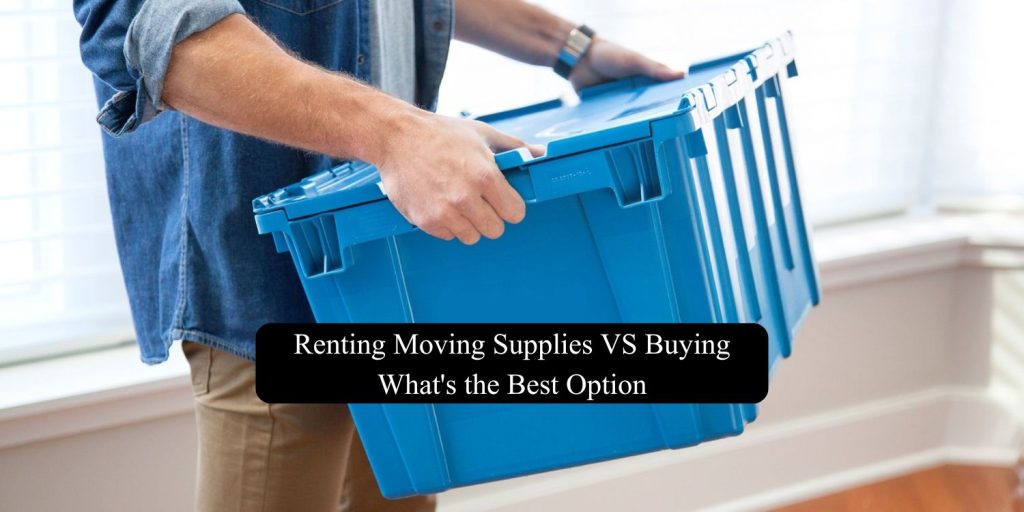Moving to a new area is usually difficult, and one of the most important decisions. You need some essential moving supplies in this process. Also, you’ll have to decide whether to rent or purchase moving goods. Both alternatives have advantages that can affect your moving experience, cost, and convenience. In this article, we’ll look at the benefits and drawbacks of renting vs purchasing moving materials, to help you decide which option is best for you.
Renting Moving Supplies:
Many people prefer to rent moving equipment including boxes, crates, and packing materials. Here’s the reasons for this preference.
Pros:
1. Cost-effective:
Renting moving boxes and crates can be much less expensive than purchasing them, especially for short-term use. When you rent, you simply pay for the period of your relocation, saving you the cost of buying stuff you will only use once.
2. Eco friendly:
Renting is an environmentally friendly option. Companies that rent moving supplies frequently reuse and recycle their items, lowering the demand for new resources and reducing waste.
3. Convenience:
Renting moving goods eliminates the need to source, purchase, and dispose of boxes and crates yourself. Many rental firms include delivery and pick-up services, making the process even easier for clients.
4. Quality assurance:
Rental firms often provide long-lasting, high-quality crates and boxes that are specifically built for transportation. This decreases the possibility of damage to your items when compared to employing cheaper, lower-quality materials.
Cons:
1. Restricted Availability:
Especially during the busiest moving seasons, rental goods might not always be accessible. If your move is scheduled during a busy time of year, you might need to reserve your supplies well in advance.
2. Duration of Rental:
Short-term rentals are the most economical. Rental expenses can mount up if you require the materials for a longer period of time or if your move is longer than expected.
3. Return Logistics:
Although renting might be practical, it does necessitate planning for the supplies’ return. If you’re moving a great distance or require more time to unpack, this could be an additional source of stress.
Buying Moving Supplies:
On the other hand, purchasing moving goods grants you entire ownership and control over your materials. Let us consider the advantages and disadvantages of this option:
Pros:
1. Unlimited Use:
Once you’ve purchased your materials, you can use them for as long as you need. This is especially useful for those who may need to store belongings for an extended period of time or who plan to relocate several times.
2. Flexibility:
When you purchase your materials, you may begin packing at your own speed without worrying about rental return deadlines. This may be less stressful for larger movements or when time restrictions are unpredictable.
3. Customization:
When you buy, you can choose exactly what you need, from box kinds to packaging materials. You can customize your purchase to meet the specific needs of your move.
4. Resale Potential:
If your moving goods are in good shape after your move, you may be able to sell them to recuperate some of your expenses.
Cons;
1. Higher Initial Cost:
Purchasing moving goods can be costly, especially if you require a large amount or specialty items.
2. Environmental Impact:
Purchasing new goods frequently leads to waste, especially if they are abandoned after a single usage. This choice is less environmentally friendly than renting.
3. Storage Needs:
After your relocation, you’ll need to find a place to keep the boxes and materials, which might be troublesome if you don’t have enough space.
Things to Consider When Purchasing or Renting Moving Supplies
Take into account the following aspects when choosing whether to purchase or rent moving supplies:
● Duration of Use:
Renting is usually more affordable if you only use the goods for a brief amount of time. In the long run, nevertheless, purchasing might be preferable.
● Environmental Concerns:
Renting is a more environmentally friendly choice if you want to leave as little of an impact as possible. Seek out businesses that use environmentally friendly products and procedures.
● Budget:
Determine your budget and consider the upfront expenditures of purchasing vs leasing payments. Remember to consider possible resale value if you decide to buy.
● Convenience:
Consider how much time and effort you can put into the procedure. Renting can save you time, however purchasing provides you greater control.
Renting Moving Supplies VS Buying – What’s the Best Option
Finally, the best option will be determined by your specific demands and circumstances. Renting moving materials is great for people seeking an environmentally responsible, cost-effective solution for short-term use. It provides ease and peace of mind with excellent products and frequently includes delivery services.
However, purchasing moving supplies may be a better option if you prefer the flexibility of long-term use, wish to customize your packing materials, or intend to move again in the future. Visit BluBox-it to find a dependable source to rent moving materials and learn about their diverse choice of eco-friendly moving options.
Conclusion:
Renting and purchasing moving materials have advantages and downsides. Your decision should be based on the duration of your move, your budget, environmental concerns, and personal preferences. By carefully considering these criteria, you may select the option that will make your transition as seamless and stress-free as possible

